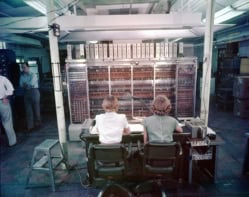Denis Weaire reviews Einstein’s Dice and Schrödinger’s Cat: How Two Great Minds Battled Quantum Randomness to Create a Unified Theory of Physics by Paul Halpern

More than a century has passed since quantum theory began to pose teasing questions about how we interpret our world. Books abound that offer alternative views of the problems the theory raises, and Einstein’s Dice and Schrödinger’s Cat is another. It begins with a few central themes and then follows the later interaction-at-a-distance of two prominent figures who had their heyday in the early 20th century and lived on to become eminences grises.
As the author, Paul Halpern, acknowledges, the pairing of Albert Einstein and Erwin Schrödinger is a somewhat unbalanced one, at least in the mind of the wider public – Einstein the universal icon with the big hair, Schrödinger playing a central role for physicists but relatively unknown to others. Even the dilemma posed by Schrödinger’s cat is not widely appreciated; Halpern notes that it derives from an earlier example put forward by Einstein, one that involved exploding gunpowder rather than poisoned pets.
Einstein was a great and a good man, but perhaps he has already received rather too much biographical attention, in comparison with his contemporaries. We need a better sense of the individual researcher as a quasiparticle, moving and acting in a sea of influences from the wider scientific community. Accordingly, Halpern’s book contains a large cast of other characters, who appear in the potted history of physics that forms the background to his tale. However, much of that which feels fresh in the book lies in the recounting of Schrödinger’s adventures in Ireland, a country to whose shores he was driven by events in his native Austria and his distaste for the high tables of Oxford (which may have been mutual).
Schrödinger was brought to Ireland in 1939 by the country’s leader Éamon de Valera, who had a quixotic enthusiasm for mathematics and theoretical physics. To the very end, when he was nearly blind, de Valera would still struggle through textbooks on the subject. In earlier times, when he dominated public life, he could often be seen striding into the seminar room of the Dublin Institute for Advanced Studies – a centre created in his own image as well as that of its Princeton counterpart – to hear the latest developments. De Valera was enamoured of relativity, and according to some, he once sent a young civil servant to find out whether it could be applied to economic policy. I met the official in question many years later. He hotly denied it. Apocryphal or not, the story conveys an impression of life on the isolated offshore island where Schrödinger was beached – not quite a Crusoe, more of a Gulliver.
It is a pity, therefore, that this author does not have a better feel for Dublin life, and that some of his details seem unreliable (for example, the Trinity College physicist G F Fitzgerald is here referred to as “Edward”). His style is also racy, sometimes uncomfortably so: terms such as narky, cushy, bragging and mouthing off do not always sit well in the story of these two dignified intellectuals. However, the aspect of the book that saddens me most (but is common to most such popular writing today) is the total absence of the elegant mathematical formulae that are the very essence of theoretical physics. Granted, lay readers cannot be given an instant tutorial on technicalities; nevertheless, one might yet hope that a few excerpts could be exhibited, with some hint of their nature and sophistication. After all, a third of a millennium has passed since Leibniz and Newton introduced the kind of mathematics that – somewhat miraculously – is still used for quantum mechanics. Moreover, the reader who cannot admire a few symbols is unlikely to understand much of the author’s talk about tensors, determinants and complex numbers.
Einstein and Schrödinger rubbed shoulders and eventually locked horns over their respective attempts to produce new unified field theories. Neither was successful. In 1947 Schrödinger jumped the gun by prematurely and publicly announcing a major breakthrough in that quest. He did so in the sedate surroundings of the Royal Irish Academy, where I once proposed that the small box by the fire escape should carry the message “In case of boredom, break glass for key”. But on that day the room must have been charged with a frisson of anticipation: de Valera himself chose to attend. The subsequent over-reaction of the press in Ireland and abroad, though hardly a “press war”, was an embarrassment, and Schrödinger went on the retreat as his relationship with Einstein cooled. They renewed their friendship in due course, but the rest of the story is one of continued decline and fall.
Of more enduring interest to most of us is the scepticism both men shared regarding probabilistic interpretations of quantum mechanics. Their standpoint is outmoded today, but we are still uneasy about the relation of the quantum and classical worlds. Accordingly, John Bell makes an entrance towards the end of the book, which brings the quantum/classical conflict up to the present day. I once had the pleasure of accompanying Bell to a dinner in Trinity College Dublin. Referring to the implications of his theorem, I asked “Is there still a problem?” Not entirely sure what I meant by this conversational gambit, I did not expect a direct reply, but he was unequivocal. “Yes,” he said. “Very well,” I said. “Who will resolve it, the physicists or the philosophers?” “The physicists,” he replied.
Bell, like these two great predecessors, is no longer with us. We still wait for whoever will finally put Schrödinger’s cat at rest, not to mention the one who will solve the small problem of unifying gravity and electromagnetism. In the meantime, this book can be put on the reading list of those who have enjoyed The Theory of Everything and want to know more.
- 2015 Basic Books £18.99/$27.99hb 288pp



